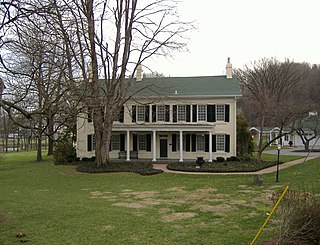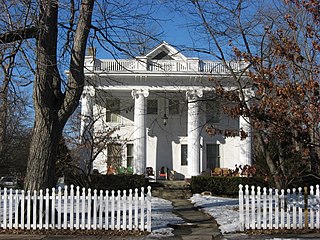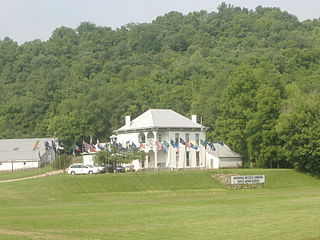
The Corydon Historic District is a national historic district located in Corydon, Indiana, United States. The town of Corydon is also known as Indiana's First State Capital and as Historic Corydon. The district was added to the National Register of Historic Places in 1973, but the listing was amended in 1988 to expand the district's geographical boundaries and include additional sites. The district includes numerous historical structures, most notably the Old Capitol, the Old Treasury Building, Governor Hendricks' Headquarters, the Constitution Elm Memorial, the Posey House, the Kintner-McGrain House, and The Kintner House Inn, as well as other residential and commercial sites.

The Kintner House Hotel is a historic bed & breakfast, in the Corydon Historic District in Corydon, Indiana. The present building was built in 1873, and is a 2+1⁄2-story, Italianate style brick building. The original Kintner House, two blocks away, was where John Hunt Morgan learned that Robert E. Lee lost at the Battle of Gettysburg. The Kintner House remained a hotel until 1920 and was used as offices until 1986. It was extensively restored and opened as a bed and breakfast in 1987.

The Kintner-McGrain House, also known as Cedar Glade, is on the National Register of Historic Places, located north of downtown Corydon, Indiana. It attained the "Cedar Glade" name due to the giant red cedars Jacob Kinter, the builder, planted in front of the house. It has been owned by three different families: Kintners (1808), McGrains(1849), and Bennetts (1998). It is the second-oldest building in Harrison County, Indiana. It was built in 1808, and is a Late Federal/Early Republic Style, "L"-shaped, brick dwelling. During John Hunt Morgan's raid in 1863, noncombatants took refuge in the house. Ironically, several cannonballs landed in the front yard. Until 1946 it was a working farm.

William H. H. Graham House, also known as the Stephenson Mansion, is a historic home located in the Irvington Historic District, Indianapolis, Marion County, Indiana. It was built in 1889, and is a 2+1⁄2-story, four-bay Colonial Revival style frame dwelling. The house features a front portico supported by four, two-story Ionic order columns added in 1923, and a two-story bay window. In the 1920s it was the home of D. C. Stephenson, head of the Indiana Ku Klux Klan.

The John Linsey (Lindsay) Rand House is a historic home located at Friendship in Brown Township, Ripley County, Indiana. It is owned by the National Muzzle Loading Rifle Association for use as their national headquarters and offices.

Culver Historic District is a national historic district located at Evansville, Indiana. The neighborhood is all residential, and unlike most of the rest of the city, the lots are not laid out on a grid. Most of the houses are on a lot previously part of the farm owned by Robert Parrett, a native of England who settled in Evansville and built a house near the intersection of Madison Avenue and Parrett Street. Eventually Robert Parrett would become the first Methodist minister in Evansville and helped found Trinity Methodist church, which he served until his death in 1860. His heirs divided up the plat in 1863.

J. Wood Wilson House, also known as the Wilson-Vaughan House and Hostess House, is a historic home located at Marion, Grant County, Indiana. It was built in 1912, and is a 2+1⁄2-story, rectangular, Colonial Revival / Georgian Revival style brick dwelling. The front facade features a projecting portico with Ionic order columns and balcony with a decorative iron railing. It was designed by noted African-American architect Samuel Plato (1882–1957).

Baldwin Addition Historic District is a national historic district located at Fairmount, Grant County, Indiana. It encompasses 14 contributing buildings and 3 contributing structures in a predominantly residential section of Fairmount. It was developed between about 1857 and 1930, and includes notable examples of Queen Anne and Greek Revival style architecture. Notable buildings include the Jonathan Baldwin House (1858), John Wilson Harvey houses, and the Gothic Revival style Fairmount Wesleyan Church (1916).

Wilson-Courtney House, also known as the Courtney House, is a historic home located at Danville, Hendricks County, Indiana. It was built between 1848 and 1850, and is a 1+1⁄2-story frame dwelling with a one-story rear ell and Greek Revival style design elements. Also on the property is a contributing smokehouse.

Crowe-Garritt House is a historic home located at Hanover, Jefferson County, Indiana. The original section was built about 1824, with later additions and modifications. It is a two-story, rectangular wood-frame vernacular dwelling with a two-story verandah. The house was the residence of John Finley Crowe, founder of Hanover College from 1824 to 1860.

Millen-Chase-McCalla House, also known as the Topolgus Building, is a historic home located at Bloomington, Monroe County, Indiana. The original section was built in 1844, and now forms the two-story brick rear wing. The two-story, brick main section was added in 1854, to form a two-thirds I-house. The house was remodeled in 1871 in a combination of Greek Revival and Italianate style architecture. It rests on a limestone foundation and has a side-gable roof. The interior has undergone renovation for commercial uses a number of times; in 2011 it was rehabilitated for use as a restaurant.

Falley Home, also known as the Lahr Home, is a historic home located at Lafayette, Tippecanoe County, Indiana. The Italian Villa style brick house was built in 1863, and consists of three two-story sections and a three-story entrance tower. It is sheathed in stucco. The square corner entrance tower is topped by a cupola and encloses a curve staircase.

Hanna–Ochler–Elder House, also known as the Hannah House, is a historic home located at Indianapolis, Marion County, Indiana. It was built in 1859, and is a 2+1⁄2-story, five-bay, Italianate style brick dwelling with Greek Revival style design elements. It has a lower two-story kitchen wing with gallery added in 1872. The house has a low-pitched hipped roof with bracketed eaves.

William N. Thompson House, also known as Old Governor's Mansion, is a historic home located at Indianapolis, Marion County, Indiana. It was built in 1920, and is Georgian Revival style buff-colored brick mansion. It consists of a two-story, five-bay, central section flanked by one-story wings. It has a slate hipped roof and features a full width front porch and an elliptical portico at the main entry. The house served as the Governor's Mansion from 1945 to 1970.

Christamore House is a historic settlement house associated with Butler University and located at Indianapolis, Marion County, Indiana. It was built between 1924 and 1926, and is 2+1⁄2-story, "U"-shaped, Georgian Revival style brick mansion. It consists of a two-story, five bay, central section flanked by one-story wings. It has a slate hipped roof and is nine bays wide, with a three bay central pavilion. The building features large round-arched windows and contains an auditorium and a gymnasium.

Horner–Terrill House is a historic home located at Indianapolis, Indiana. It was built about 1875, and is a 2+1⁄2-story, roughly "L"-shaped, Second Empire style brick dwelling with limestone detailing. It features a three-story tower, mansard roof, and round arched openings. Also on the property is a contributing garage. It was listed on the National Register of Historic Places in 2013.

Mount Pisgah Lutheran Church, also known in its early years as the First Lutheran Church and First English Lutheran Church and more recently as The Sanctuary on Penn, is located at 701 North Pennsylvania Street in downtown Indianapolis, Indiana. The historic church was built by the city's first Lutheran congregation, which organized in 1837, and was its third house of worship. The former church, whose present-day name is The Sanctuary on Penn, is operated as a for-profit event venue.

St. Philip Neri Parish Historic District is a historic Roman Catholic church complex and national historic district located at Indianapolis, Indiana. The district encompasses five contributing buildings: the church, rectory, former convent and school, school, and boiler house / garage. The church was built in 1909, and is a Romanesque Revival brick church with limestone trim. It features two- and three-story crenellated corner towers, a rose window with flanking round arched windows, and Doric order columns flanking the main entrance.

Shortridge–Meridian Street Apartments Historic District is a national historic district located at Indianapolis, Indiana. The district encompasses 136 contributing buildings in a predominantly residential section of Indianapolis. It was developed between about 1900 and 1951, and includes representative examples of Colonial Revival, Classical Revival, Late Gothic Revival, Mission Revival, Renaissance Revival, Bungalow / American Craftsman, and Art Deco style architecture. Located in the district is the separately listed Shortridge High School. Other notable buildings include the Vernon Court Apartments (1928), Fronenac Apartments (1951), Biltmore Apartments (1927), Meridian Apartments (1929), New Yorker Apartments (1917), Howland Manor (1929), Powell-Evans House (1911), Harms House (1906), Dorchester Apartments (1921), and Martin Manor Apartments (1916).

Indianapolis Chair Manufacturing Company, also known as the Indianapolis Warehouse, was a historic factory complex located at Indianapolis, Indiana. It was between built 1891 and 1893, and consisted of three sections. It included two large six-story brick sections with segmental arched windows and an eight-story corner tower. It has been demolished and replaced by an apartment complex.
























